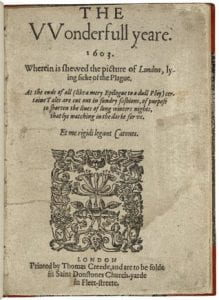By Dr Eleanor Rycroft
When the coronavirus outbreak hit I was halfway through reading Maggie O’Farrell’s Hamnet. As I continued to read this book about the loss of William Shakespeare’s son to plague, the pandemic developed throughout March, and a transformation occurred to the material. The book changed from being a historical, if heart-breaking, account of the death of a child, to a strangely prescient and very present tale about the sudden loss of anyone to an invisible illness. Ideas that had felt distant became suddenly close; fears that were one imagined were now being plucked from my own brain.
For the last year or so, I have been working on a research project which explores the staging and the meaning of walking in early modern drama. As a rule my research concerns bodies in performance, and I draw on a wide range of printed texts in circulation at the same time as drama to analyse how early modern bodies were understood and represented onstage. Like my experience of reading Hamnet, my response to my research has been transformed by the crisis we are living through.
Whereas, prior to March, I was writing blithely in my notes about “bad plague years” and the effect that these were having on movement and mobility in early modern literature, the material suddenly became more vital and, once again, prescient. The frequent closures of the playhouses during the late sixteenth- and early seventeenth centuries because of plague outbreaks, suddenly spoke to the theatres going dark in our present moment.
During 1603, the year that James VI of Scotland took to the throne as James I of England, a particularly bad outbreak of plague occurred, one that caused the death of 1 in 5 Londoners and continued on and off for the next 10 years. It was in this context that Ben Jonson created The Alchemist in 1610, a play which presents the machinations of servants in the absence of their master who has fled London due to an outbreak of the illness.
Outside of the theatres James VI and I issued a set of Orders in 1603 for the prevention of the plague – including a 6-week quarantine of the sick, and an injunction that if they leave their home then they should mark their clothes for identification. However, a large number of other medical treatises were written around this time. Prior to coronavirus, I had found one of these – James Manning’s A new booke, intitled, I am for you all, complexions castle as well in the time of the pestilence (1604) – particularly interesting, because of Manning’s advice that you should ‘command’ those that you suspect as sick to perform certain physical tasks for you:
“If you suspect any, as you may justly, where some have died out of a house, or where the next house have had the infection, then do as followeth; Command them to stand upright, and to reach themselves upright: if they faile to do it, then suspect a sore in the backe, bellie, brest, or flanks […] presently after this, command them to walke up and downe as fast as they can; if they halt, or steppe not largely, suspect a sore in the thighs, flanks, knees, backe, or hippes: presently after this, command them to bow down foreward to the ground, and reach up something, not removing any foote, if they cannot, then suspect the flanks, or backe: if they do performe all this, and be very short winded, having no other disease knowne; then suspect a soare to ensue, or the bodie very shortly to be in great danger by the pestilence.” (1604, E2r-v)

As I read the same text now, it seems to imply a similar distrust of others that has led some people to spy on their neighbours during lockdown. Pandemics may bring out some of the best in us – Clap for Carers, Colonel Tom Moore – but they also appear to bring out some of our worst.
While Manning is from Wellingborough, the place bearing the brunt of the plague – as with coronavirus – is London. In 1603, the playwright and pamphleteer Thomas Dekker published The Wonderfull Yeare, a text which considers all of the strange (or ‘full of wonder’) events, from Elizabeth’s death, to James’ inauguration, to the plague itself. In it, he makes the point that once the ‘pestilence’ takes hold of the body, it has the potential to punish even the strongest and fittest of us, resonating with our disbelief when we hear of somebody who has died of COVID-19 ‘with no underlying health conditions’:
“How nimble is Sickness, and what skill hath he in all the weapons he playes withall? The greatest cutter that takes up the Mediterranean Ile in P[au]les for his Gallery to walke in, cannot ward off his blowes. Hes the best Fencer in the world […] he’ll make you give him ground […] and beat you out of breath, though Aeolus himselfe plaid upon your wind-pipe.” (1603, D4r)
 For all of our understanding that certain structural, economic and physiological factors make some people more susceptible to COVID-19, Dekker’s comment upon the indiscriminate nature of illness brings his text right into our present moment, even while the references to the St. Paul’s and fencing locate it firmly in the past. By invoking St. Paul’s Cathedral, Dekker provides the reader with a glimpse of a London locale which was far more than simply a place of worship in the seventeenth-century, but rather one which bustled with cultural and commercial activity.
For all of our understanding that certain structural, economic and physiological factors make some people more susceptible to COVID-19, Dekker’s comment upon the indiscriminate nature of illness brings his text right into our present moment, even while the references to the St. Paul’s and fencing locate it firmly in the past. By invoking St. Paul’s Cathedral, Dekker provides the reader with a glimpse of a London locale which was far more than simply a place of worship in the seventeenth-century, but rather one which bustled with cultural and commercial activity.
The ‘Mediterranean Aisle’ was the name given to the central walkway of the Cathedral and Dekker draws our attention not only to the parading around which took place in the church but also, implicitly, the connection between social proximity and disease. A later pamphlet written by Dekker provides us with a vivid sense of what it meant to walk in St. Paul’s at that time, and of how easy it must have been for disease to spread in such a crowded setting at the very heart of the city:
“What layinge of heads is there together […] What shuffling, what shouldering, what Justling, what Jeering, what biting of Thumbs to beget quarrels, what holding up of fingers to remember drunken meetings, what braving with Feathers, what bearding with Mustachoes, what casting open of cloakes to publish new clothes […] I heare such trampling up and downe, such spitting, such [ha]lking, and such humming, (euery mans lippes making a noise, yet not a word to be understoode) […]
For at one time, in one and the same ranke, yea, foote by foote, and elbow by elbow, shall you see walking, the Knight, the Gull, the Gallant, the upstart, the Gentleman, the Clowne, the Captaine, the Appel-squire, the Lawyer, the Usurer, the Cittizen, the Banker, the Scholler, the Begger, the Doctor, the Ideot, the Ruffian, the Cheater, the Puritan, the Cut-throat, the Hye-men, the Low men, the True-man, and the Thiefe: of all trades & professions some, of all Countryes some; And thus dooth my middle Isle shew like the Mediterranean Sea […] Thus am I like a common Mart where all Commodities (both the good and the bad) are to be bought and solde.” (1608, D4v-Er)
Sadly one of the commodities being brought to this roiling sea of London society is the plague itself. There is still widespread disagreement among historians and epidemiologists about whether the plague was spread by animals and insects or through human-human contact, but there was clearly a sense among early moderns themselves that proximity was a factor in catching the disease. In Dekker’s depiction of bodies spitting, touching, and rubbing against each other, the potential for transmission is clear: there is saliva on people’s fingers, there is face-touching, and there is the flourishing of potentially infected clothes.
With such an emphasis on faces and mouths and fabrics, you can almost see infectious droplets pass through the air. With such a social mix and volume of people, you can almost sense the viral load. While these terms may not have been available to early modern people – or to me, a couple of months ago – they inhere in texts from the 1600s that are themselves contaminated by an ever-present plague. They underscore these texts’ responses to the body and reveal our inability as social creatures, really, to remain socially distanced for long.
Cited works
https://www.shakespeare.org.uk/explore-shakespeare/blogs/sovereign-and-sick-city-1603/
Dekker, Thomas, The dead tearme (London,1608)
Dekker, Thomas, 1603. The vvonderfull yeare (London, 1603)
Jonson, Ben, The Alchemist (London, 1612)
Manning, James, A new booke, intitled, I am for you all, complexions castle as well in the time of the pestilence (London, 1604)
O’Farrell, Maggie, Hamnet (Knopf Doubleday Publishing Group, 2020).
